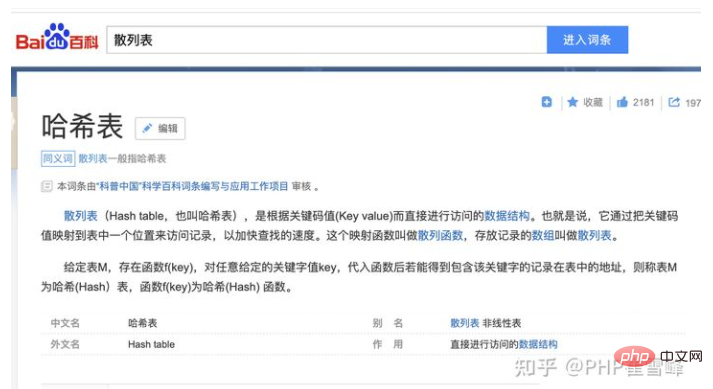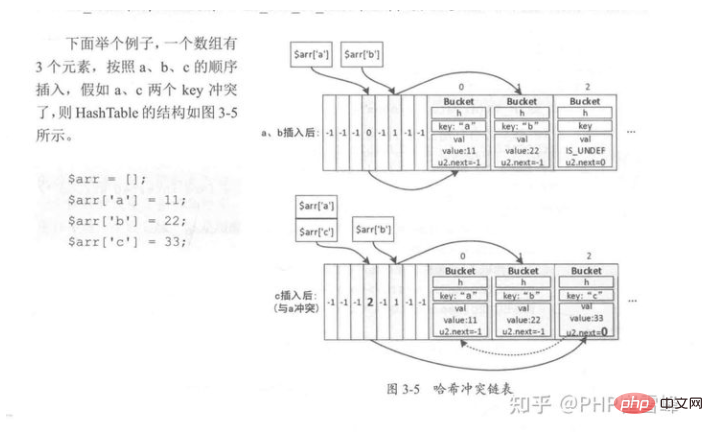
This article introduces to you "Analysis of PHP8 underlying kernel source code - array (3)". It has certain reference value. Friends in need can refer to it. I hope it will be helpful to everyone.
Recommended related articles: "Analysis of PHP8 underlying kernel source code - array (1) " "Analysis of PHP8 underlying kernel source code - array (2) " Analysis of PHP8 underlying kernel source code - array (4) 》
The above has fully analyzed the basic structure implementation of arrays in PHP and the composition principle of indexes
Relying on the two structures _Bucket and _zend_array
The complexity of o(1) is realized through the hash function
But there is an index array before the bucket. I was understanding this index array at the time I walked through a lot of pitfalls
The picture below is $c =array('x'=>1,'y'=>2,'z'=>3,'a '=>0); The bucket structure of array c

If it is packed, the key is directly nullThere is no need to calculate the hash value. This index array is only used to quickly locate the h value
 $a =array(1,2,3) bucket
$a =array(1,2,3) buckettypedef struct _Bucket {
zval val; //数组的值 ( 复习下 zval只有16个字节)
zend_ulong h; // key的 h 值
zend_string *key; //当数组为 hash_array时候 会用到 也就是 key的值
} Bucket;array Don't let val affect your learning ideas at this time. The h value is equal to the subscript of the position of the array (arrays all start from 0, so the subscript also starts from 0). For example, $b =array(1=>'a',3=>'b',5=>'c'); mentioned above, where array b is also packed_array and has the following structure

The structure is as follows


Hash table mainly consists of two parts: storage element array and hash function. A simple hash function can use the remainder method. For example, if the size of the hash table is 8, then when the hash table initializes the array, allocate a space of 8 elements. Follow up the hash code of the key and divide it by 8. The value obtained is this The index of the element in the array. In this way, the key can be mapped to the specific location in the storage array

But there is a problem in directly implementing the array in the above way: The position of the elements in the array is random and it is unordered
The array in PHP is ordered, so it adds an index table between the hash function and the element array. This index table is also an array. . The size is the same as the array in which the elements are stored. However, the element type it stores is always an integer, which is used to save the subscript of the element array in the actual stored array: the elements are inserted into the actual stored array in order, and then the array subscript is calculated according to the hash function. The position is stored in the newly added index.

The first step is to calculate 4 and then find -4 in the index table. Because this is the 0th array, put it in the index table The value in the -4th array is set to 0, and then the 0th element in the real array table is set to the real assigned zval
key of different elements in the hash table. The final hash value calculated may be The same thing is that a hash conflict will occur when pointing to a subscript in the same index table. Because the index table can only store one element, PHP uses the zipper method to achieve hash conflict, which is to pull up the value in a linked list. You can refer to the picture below "PHP7 Kernel Analysis - Qin Peng"

▏This article was published on the PHP Chinese website with the consent of the original author PHP Cui Xuefeng. The original address: https://zhuanlan.zhihu.com/p/360952022
The above is the detailed content of Parsing PHP8 underlying kernel source code - array (3). For more information, please follow other related articles on the PHP Chinese website!
 What are the definitions of arrays?
What are the definitions of arrays?
 js string to array
js string to array
 Array initialization method
Array initialization method
 c array initialization method
c array initialization method
 How to find the maximum and minimum value of array elements in Java
How to find the maximum and minimum value of array elements in Java
 How to remove the first few elements of an array in php
How to remove the first few elements of an array in php
 Summary of java basic knowledge
Summary of java basic knowledge
 Zero-based Java self-study tutorial
Zero-based Java self-study tutorial




